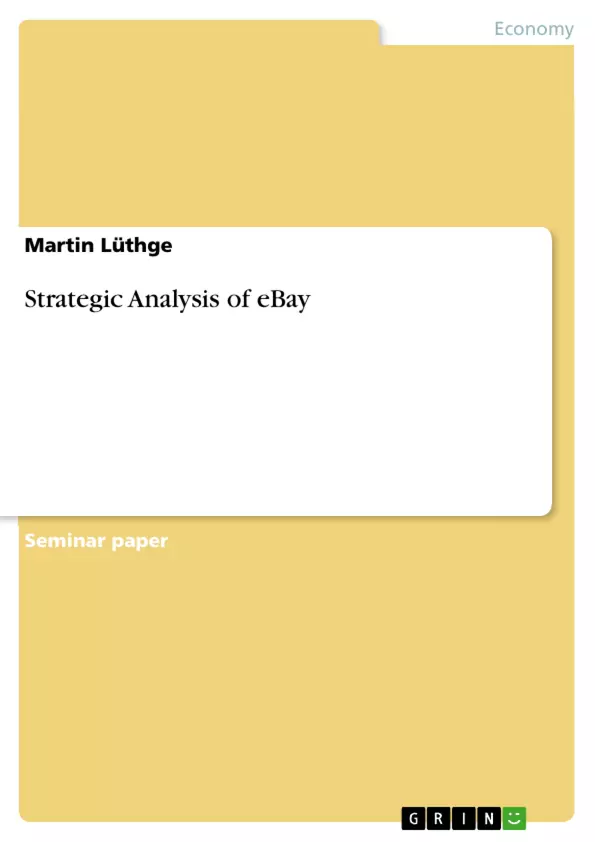In the middle of the 90’s, the importance of the Internet increased significantly. Due to the prognosticated prospects and expectations of the Internet, it did not need a long time until innumerable companies with business models focused on the Internet were established. Only few of these Internet business models have reached an international size or work profitable so far.
However, one of the companies, which reached theses objectives, is eBay. Within this strategy paper, the development of the enterprise and the strategic figures are identified, analysed and evaluated. Furthermore, an evaluation of the environment, the market, the competition as well as financial indices was conducted, in order to evaluate the development potentials as well as the future chances and risks of the company.
Inhaltsverzeichnis (Table of Contents)
- Introduction
- Company View
- Founding and Management
- Company Expansion
- Company Figures and Strategic Changes
- Market View
- Market Potential
- PESTEL Analysis
- Competitive Forces
- Financial Positioning
- SWOT Analysis
- Conclusions
Zielsetzung und Themenschwerpunkte (Objectives and Key Themes)
This strategy paper aims to analyze the development, strategic figures, and future potential of eBay, a company that has achieved significant success in the online market. The paper explores the company's origins, growth strategies, and the competitive landscape it operates within. Additionally, it analyzes the company's financial positioning and future opportunities.
- The rise and expansion of eBay's business model
- Analysis of eBay's market position and competitive landscape
- Evaluation of eBay's financial performance and growth potential
- Assessment of the strategic changes eBay has implemented
- Exploring the evolution of eBay from a C2C (customer-to-customer) to a B2C (business-to-customer) market
Zusammenfassung der Kapitel (Chapter Summaries)
Introduction: This chapter sets the stage by highlighting the rapid growth of the internet in the mid-1990s and the emergence of numerous internet-based businesses. The chapter focuses on eBay as an example of a company that has achieved significant success within this context, outlining the scope of the strategy paper.
Company View: This chapter delves into the founding, management, and expansion of eBay. It highlights the key milestones in the company's development, from its early beginnings to its global presence. The chapter also analyzes eBay's expansion strategies, including acquisitions and the importance of being a first mover in the market. It further examines the company's strategic changes, such as the introduction of the "buy it now" feature and the development of "eBay stores."
Market View: This chapter explores eBay's market potential, analyzing the size of the global internet user base and eBay's market share within that context. The chapter further examines the competitive forces at play in the online trading market, including a PESTEL analysis and an assessment of eBay's financial positioning. It also covers eBay's SWOT analysis, offering a comprehensive evaluation of the company's internal and external factors.
Schlüsselwörter (Keywords)
This strategy paper focuses on the development and success of eBay as an online trading platform. Key concepts include online marketplaces, e-commerce, business models, strategic expansion, market potential, competitive landscape, financial performance, and the evolution of eBay's business model from a C2C to a B2C market.
- Citar trabajo
- Martin Lüthge (Autor), 2003, Strategic Analysis of eBay, Múnich, GRIN Verlag, https://www.grin.com/document/185885



